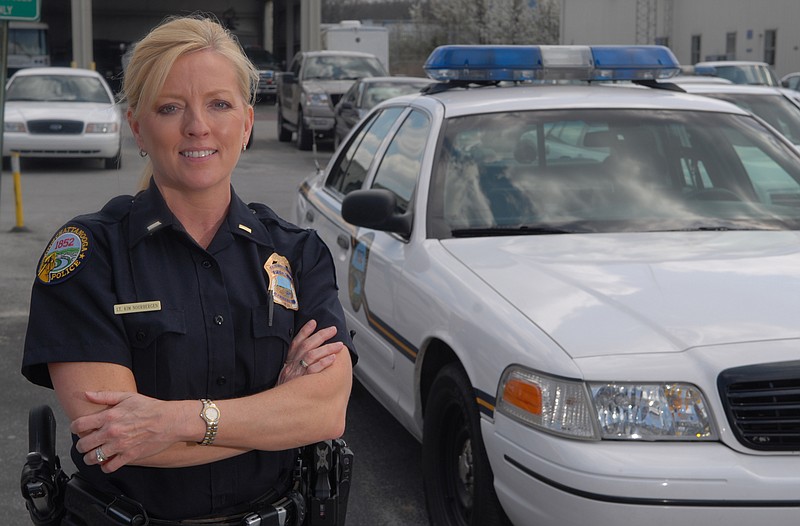First-year patrol officer Kim Noorbergen was working the midnight shift, driving down a street known as "Crack Alley," when two people flagged her down and said they'd been robbed. On that night in 1990, they told her the man who robbed them was standing on a nearby porch. As Noorbergen walked up to the porch, she recognized the suspect - he was a regular, someone she'd dealt with again and again.I heard the 'click, click. We started struggling. I knew he had a gun. And I knew he was trying to shoot me."
Noorbergen had him turn around and put his hands up. She started to pat him down, beginning with his left side. Then the man reached into his back right waistband and pulled out a revolver.
A man inside the home yelled, "He's got a gun!" The suspect put the gun to Noorbergen's head and pulled the trigger twice.
It misfired both times.
"I heard the 'click, click,'" Noorbergen said Thursday. "We started struggling. I knew he had a gun. And I knew he was trying to shoot me."
As they struggled and went to the ground, the man tried to pull her service weapon from its holster but couldn't. She pushed him off and he took off running. She ran after him but lost him in an alley.
He was arrested the next day and eventually was convicted of aggravated assault.
Twenty-six years later, Noorbergen is a captain at the Chattanooga Police Department, and part of her job is to oversee training - to prepare new officers to face the wrong end of a gun, like she did.
Last week the U.S. Department of Justice released a new report on firearm assaults against police officers that shows Chattanooga officers face more firearm assaults than the national average for a city of its size.
Nationally, the average rate for firearm assaults against police officers in cities with populations between 100,000 and 250,000 is 7.2 assaults per 100,000 people, according to the report. But in Chattanooga, that number is 18.2.
The report looked at firearm assaults against police officers nationwide between 2007 and 2011. In that five-year period, the report found 31 firearm assaults against Chattanooga police officers. That includes incidents where shots were fired as well as where a gun was used in a struggle but not fired.
That's about six firearm assaults against officers per year. But some Chattanooga officers estimate the number of incidents is actually higher than the Department of Justice report found. The police department doesn't formally track shooting incidents against officers, but did confirm officers were shot at during four incidents in 2015 - including the terrorist attack on July 16.
Noorbergen said she thinks more criminals are armed today than at the start of her career.
"Twenty years ago, you could go on a burglary and chances are the suspect probably wasn't armed," she said. "Because their intent was to go in, get what they wanted and get out. Nowadays, you don't know - because everybody is armed. We assume everybody is armed."
In total, the report found 1,014 firearm assaults across the United States between 2007 and 2011 that resulted in injuries to officers, and 10,149 that did not result in injuries. The report also found 148 officers were killed in firearm assaults.
The report gives recommendations for law enforcement agencies to improve officer safety before and during firearm assaults. The study says agencies and researchers should do more analysis of when and where such assaults happen, and data already collected federally should be released faster so it can be more useful to agencies. It also offers training recommendations.
Chattanooga Police Chief of Staff David Roddy said the department recently has focused on improving its intelligence so officers know what they're walking into.
"When you come out of [training] as a brand new police officer, in my day, it was a year before you knew who was who," he said. "You had to get out there, talk to folks, answer calls and make traffic stops before you really realized who was driving the crime in your district, who lived there, who traveled through and who'd never been there. But with intelligence, we're giving our officers the ability to know as much as possible about an individual before they ever have that first encounter."
He hopes that the department's increased intelligence will allow officers to know ahead of time whether a person has been violent before, or been violent against a police officer before.
New police officers also go through 117 hours of firearms use of force training, Noorbergen said, and officers go through refresher training throughout their careers. The training is designed to teach officers to make appropriate split-second decisions, Roddy said. Tiny decisions - like whether to turn on a flashlight - can change the outcome of an entire incident, he added.
"[In our training,] quick decisions and correct decisions are what lead to positive outcomes, not luck," he said. "Because you can't rely on luck."
Looking back now, Noorbergen said she thinks her experience that night on the porch made her a better officer.
"I know it made me stronger," she said.
She realizes now she may have had a false sense of security as she patted the man down that night because she'd interacted with him so frequently in the past. She credits her training for her survival.
"I had dealt with him time and time again, but he turned on me," she said. "He had never been a problem to me before, but he turned on me and tried to kill me."
Contact staff writer Shelly Bradbury at 423-757-6525 or sbradbury@timesfreepress.com with tips or story ideas. Follow @ShellyBradbury.
